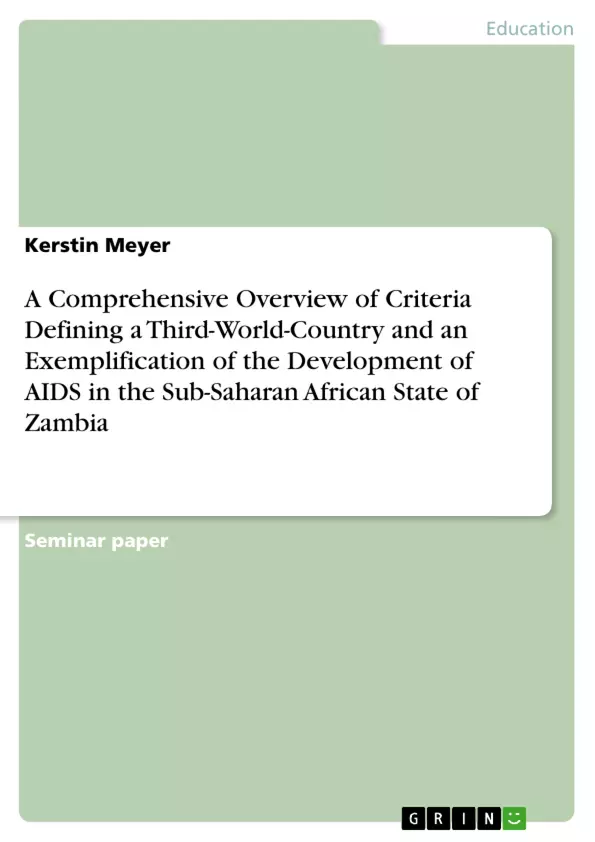In the Seminar “Corporation for Development and Education - the case of El Salvador” we focused on the problems of Developing Countries and Third World Countries. The target of this overview is to show the different criteria which classify a developing country and to give a short description how the situation of one criteria is labelled and what consequences this has. As each topic could form an essay in itself, I can only give a short explanation. In the second passage of this essay I will focus the situation of AIDS in one African state, Zambia, up from history to recent statistics and prospects of the future. [...]
Inhaltsverzeichnis (Table of Contents)
- 1. Introduction
- 2. Which criteria characterize a developing country?
- 2.1 Economics
- 2.1.1 Low Added Value
- 2.1.2 Export
- 2.1.3 High Unemployment
- 2.1.4 Poverty
- 2.2 Ecology
- 2.2.1 Rain forest
- 2.2.2 Desertification
- 2.2.3 Urbanization
- 2.3 Demography
- 2.3.1 Population growth
- 2.3.2 Low life expectancy
- 2.3.3 Childhood mortality
- 2.4 Physical Health
- 2.4.1 Food
- 2.4.2 Hunger
- 2.4.3 Water
- 2.4.4 AIDS
- 2.5 Sociocultural attributes
- 2.5.1 Situation of women
- 2.5.2 Child labour
- 2.6 Political attributes
- 2.6.1 Political instability
- 2.6.2 Corruption
- 2.6.3 Human rights
- 3. Prevalence of AIDS in Africa
- 3.1 One Example: Zambia
- 3.1.1 History of AIDS in Zambia
- 3.1.2 Ways of HIV Transmission and cultural features
Zielsetzung und Themenschwerpunkte (Objectives and Key Themes)
This overview aims to define the criteria that classify a developing country and illustrate the consequences of these characteristics using the example of AIDS in Zambia. Due to the breadth of the topic, explanations are concise. The paper first outlines the various economic, ecological, demographic, health, sociocultural, and political factors that contribute to a country's classification as developing. It then focuses specifically on the prevalence and impact of AIDS in Zambia.
- Defining characteristics of developing countries
- Economic indicators of underdevelopment
- The impact of ecological factors on development
- Demographic trends in developing nations
- The AIDS epidemic in Sub-Saharan Africa
Zusammenfassung der Kapitel (Chapter Summaries)
1. Introduction: This introductory chapter sets the stage for the paper, explaining its purpose as an overview of the criteria used to define a developing country and the subsequent examination of the AIDS situation in Zambia. It acknowledges the limitations of brevity, promising a concise explanation of each criterion and a focus on Zambia's AIDS crisis in the latter part of the paper. The introduction highlights the disproportionate population distribution between developed and developing nations, emphasizing the significance of studying this disparity.
2. Which criteria characterize a developing country?: This chapter delves into the multifaceted criteria used to define a developing country. It emphasizes that these criteria are indicative of underlying structural issues and contrasts their significance in developed versus developing nations. The chapter systematically categorizes these criteria into economic, ecological, demographic, physical health, sociocultural, and political aspects, offering a broad overview of each. Each section elaborates on the specific challenges faced within these categories. For example, within economics, the low added value of primary sector production and its impact on income and investment are discussed. The chapter also addresses the high unemployment rates, differentiating between open and hidden unemployment and exploring its causes both in rural and urban settings.
Frequently Asked Questions: Comprehensive Language Preview
What is the purpose of this document?
This document provides a comprehensive language preview, including the table of contents, objectives and key themes, chapter summaries, and keywords. It aims to define the criteria that classify a developing country and illustrate the consequences of these characteristics using the example of AIDS in Zambia.
What topics are covered in the Table of Contents?
The Table of Contents outlines the structure of the document. It begins with an introduction, followed by a chapter detailing the criteria characterizing a developing country (broken down into economic, ecological, demographic, physical health, sociocultural, and political aspects). The document concludes with a chapter focusing on the prevalence of AIDS in Africa, specifically using Zambia as a case study.
What are the key objectives and themes of this document?
The main objectives are to define the characteristics of developing countries and to illustrate these characteristics through the case study of AIDS in Zambia. Key themes include defining characteristics of developing countries, economic indicators of underdevelopment, the impact of ecological factors, demographic trends, and the AIDS epidemic in Sub-Saharan Africa.
What are the key criteria used to characterize a developing country?
The document categorizes the criteria into six key areas: economic (low added value, export dependence, high unemployment, poverty); ecological (rainforest depletion, desertification, urbanization); demographic (population growth, low life expectancy, high childhood mortality); physical health (food insecurity, hunger, water scarcity, AIDS); sociocultural (situation of women, child labor); and political (political instability, corruption, human rights violations).
What is the focus of the chapter on AIDS in Africa?
This chapter uses Zambia as a case study to illustrate the impact of AIDS in a developing country. It explores the history of AIDS in Zambia and examines the relationship between HIV transmission and cultural factors.
What is the scope and limitations of this document?
The document acknowledges its concise nature due to the breadth of the topic. Explanations are brief, offering an overview rather than an in-depth analysis of each criterion and focusing specifically on the AIDS crisis in Zambia.
What is the significance of using Zambia as a case study?
Zambia serves as a specific example to illustrate the consequences of the characteristics identified as typical of developing countries, providing a concrete application of the broader theoretical framework presented in the document.
- Quote paper
- Kerstin Meyer (Author), 2006, A Comprehensive Overview of Criteria Defining a Third-World-Country and an Exemplification of the Development of AIDS in the Sub-Saharan African State of Zambia, Munich, GRIN Verlag, https://www.grin.com/document/68380



